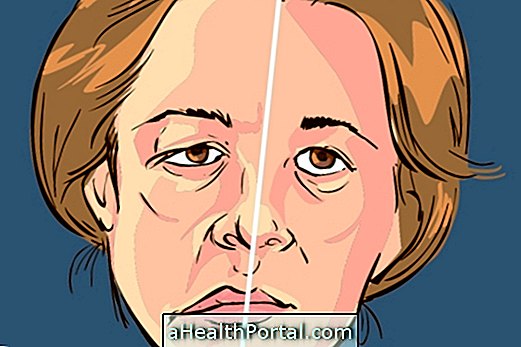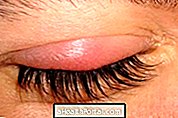Facial paralysis, also known as Bell's palsy, is a neurological disorder that occurs when the facial nerve is affected for some reason, leading to symptoms such as difficulty moving the face, lack of expression on one part of the face, or just tingling sensation.
Most of the time, facial paralysis is temporary, arising after being exposed to very cold temperatures or when you are going through a period of stress, but it can also be a sequel to more serious problems such as an infection or stroke, for example.
So if paralysis does not improve after 1 or 2 days it is important to consult a general practitioner to identify if there is any other problem that needs treatment. In addition, if other symptoms such as disorientation, weakness in other parts of the body, fever or fainting occur, it is important to go to the doctor immediately.

Main symptoms
The most frequent symptoms of facial paralysis, or Bell's, are:
- Mouth crooked, which is most evident when trying to smile;
- Dry mouth;
- Lack of expression on one side of the face;
- Inability to close one eye completely, raise one eyebrow or frown;
- Headache or jaw;
- Increased sensitivity of the sound in one ear.
The diagnosis of facial paralysis is made through the observation of the doctor and, in most cases, it is not necessary to perform complementary tests. However, to make sure that it is only a facial paralysis, magnetic resonance imaging can be used.
How is the treatment done?
Treatment for facial paralysis is done by taking medications such as Prednisone, use of eye drops, antivirals and physical therapy.
The use of artificial eye drops or tears is essential to keep the affected eye properly hydrated and decrease the risk of corneal injury. For sleep, one should apply an ointment prescribed by the doctor and wear an eye protection, such as a blindfold, for example.
How is physiotherapy done?
Physical therapy uses facial exercises to strengthen muscles and improve facial movements and expressions. However, it is important that these exercises be performed several times a day, every day, to potentiate the treatment. Therefore, in addition to sessions with the physiotherapist, it is essential to do the exercises at home.
Check out a few examples of exercises that can be done for Bell's palsy.
What can cause paralysis
Facial paralysis occurs due to the involvement of the nerves of the face that leaves the facial muscles paralyzed. Some of the possible causes of paralysis are:
- Sudden temperature change;
- Stress;
- Trauma;
- Viral infection with herpes simplex, herpes zoster, Cytomegalovirus or others;
- Rarely, it can be a consequence of other diseases.
Thus, paralysis can occur in the path of the facial nerve still inside or outside the brain. When it occurs inside it is a consequence of the stroke and when it occurs outside it is easier to be treated and in this case the paralysis is called Bell's facial palsy.




















